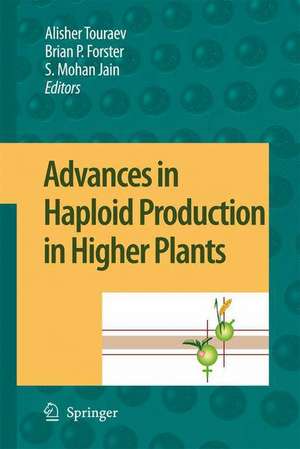Advances in Haploid Production in Higher Plants
Editat de Alisher Touraev, Brian P. Forster, Shri Mohan Jainen Limba Engleză Hardback – 5 dec 2008
| Toate formatele și edițiile | Preț | Express |
|---|---|---|
| Paperback (1) | 1199.17 lei 43-57 zile | |
| SPRINGER NETHERLANDS – 19 oct 2010 | 1199.17 lei 43-57 zile | |
| Hardback (1) | 1205.23 lei 43-57 zile | |
| SPRINGER NETHERLANDS – 5 dec 2008 | 1205.23 lei 43-57 zile |
Preț: 1205.23 lei
Preț vechi: 1469.79 lei
-18% Nou
Puncte Express: 1808
Preț estimativ în valută:
230.73€ • 237.29$ • 191.41£
230.73€ • 237.29$ • 191.41£
Carte tipărită la comandă
Livrare economică 17 februarie-03 martie
Preluare comenzi: 021 569.72.76
Specificații
ISBN-13: 9781402088537
ISBN-10: 1402088531
Pagini: 350
Ilustrații: XII, 348 p.
Dimensiuni: 155 x 235 x 26 mm
Greutate: 0.68 kg
Ediția:2009
Editura: SPRINGER NETHERLANDS
Colecția Springer
Locul publicării:Dordrecht, Netherlands
ISBN-10: 1402088531
Pagini: 350
Ilustrații: XII, 348 p.
Dimensiuni: 155 x 235 x 26 mm
Greutate: 0.68 kg
Ediția:2009
Editura: SPRINGER NETHERLANDS
Colecția Springer
Locul publicării:Dordrecht, Netherlands
Public țintă
ResearchCuprins
Progress in Doubled Haploid Technology in Higher Plants.- Doubled Haploids via Gynogenesis.- Overview of Barley Doubled Haploid Production.- Production of Doubled Haploids in Brassica.- An Overview on Tobacco Doubled Haploids.- An Overview of Triticale Doubled Haploids.- Patents and Haploid Plants.- Gene Expression Profiling of Microspore Embryogenesis in Brassica napus.- Expression Profiles in Barley Microspore Embryogenesis.- Proteomics in Rapeseed Microspore Embryogenesis.- Programmed Cell Death and Microspore Embryogenesis.- Albinism in Microspore Culture.- Doubled Haploids in Breeding Winter Oilseed Rape.- Anther Culture Derived Doubled Haploids in Oat.- Barley and Wheat Doubled Haploids in Breeding.- Rice Doubled Haploids and Breeding.- Potato Haploids and Breeding.- Current Status of Doubled Haploids in Medicinal Plants.- Microspore Embryogenesis in Selected Medicinal and Ornamental Species of the Asteraceae.- Carrot Doubled Haploids.- Haploids and Doubled Haploids in Fruit Trees.- Haploidy in Tef.- A Novel and Reversible Male Sterility System Using Targeted Inactivation of Glutamine Synthetase and Doubled Haploidy.- Embryogenic Pollen Culture: A Promising Target for Genetic Transformation.- Immature Pollen as a Target for Gene Targeting.- Induction of Semi-Dwarf, Salt Tolerant Rice Mutants from a Tall Salt Tolerant Indica Landrace.- Chromosome Doubling in Monocots.- Tracking Gene and Protein Expression During Microspore Embryogenesis by Confocal Laser Scanning Microscopy.
Recenzii
From the reviews:
"The book has twenty-eight chapters compiled by international authors, many of whom have a wealth of experience because of their long involvement in this field of research. … The volume is highly recommended as an addition to any library. It will be a very valuable source of information for personnel involved in research and teaching in academia, and for persons with a more ‘industrial’ bias." (M. R. Davey, Annals of Botany, Vol. 104 (7), 2009)
“This volume … attempts to give a broad overview of this wide topic, and also presents some recent findings and concepts. … No doubt any researcher in haploid production would find this a very valuable source of information … and drawing on the expertise of many of the acknowledged leaders in this area of science. For a general reader, there is a wide range of chapters, encompassing useful subjects such as patents and haploids, and in many cases providing a wealth of information … .” (Steve Millam, Experimental Agriculture, Vol. 46 (1), 2009)
"The book has twenty-eight chapters compiled by international authors, many of whom have a wealth of experience because of their long involvement in this field of research. … The volume is highly recommended as an addition to any library. It will be a very valuable source of information for personnel involved in research and teaching in academia, and for persons with a more ‘industrial’ bias." (M. R. Davey, Annals of Botany, Vol. 104 (7), 2009)
“This volume … attempts to give a broad overview of this wide topic, and also presents some recent findings and concepts. … No doubt any researcher in haploid production would find this a very valuable source of information … and drawing on the expertise of many of the acknowledged leaders in this area of science. For a general reader, there is a wide range of chapters, encompassing useful subjects such as patents and haploids, and in many cases providing a wealth of information … .” (Steve Millam, Experimental Agriculture, Vol. 46 (1), 2009)
Textul de pe ultima copertă
The discovery of haploid Datura plants in 1964 initiated great excitement in plant breeding and genetics communities. Recent years have witnessed a resurgence of activities especially in developing protocols, identifying genes and mechanisms and large scale commercial take up.
The identification of controlling genes has driven functional genomic studies which now dovetail with studies in gene expression, metabolism and changes in cell ultra-structure. World wide take up by plant breeders has been no less impressive, and valuable haploid technologies are increasingly patent protected. The intense activity in haploid research has also resulted in unexpected findings with novel applications.
The core of this book is based on the international symposium on "Haploidy in Higher Plants III", (Vienna 2006), which attracted top international experts in the field. Other invited contributions have been included to provide a rounded view of activities. The book covers topics in: Historical Overviews; Basic Biology; Genetics; Biotechnology; Breeding and Novel Applications. It therefore will appeal to undergraduate students,researchers and small and large scale commercial biotechnology companies.
The identification of controlling genes has driven functional genomic studies which now dovetail with studies in gene expression, metabolism and changes in cell ultra-structure. World wide take up by plant breeders has been no less impressive, and valuable haploid technologies are increasingly patent protected. The intense activity in haploid research has also resulted in unexpected findings with novel applications.
The core of this book is based on the international symposium on "Haploidy in Higher Plants III", (Vienna 2006), which attracted top international experts in the field. Other invited contributions have been included to provide a rounded view of activities. The book covers topics in: Historical Overviews; Basic Biology; Genetics; Biotechnology; Breeding and Novel Applications. It therefore will appeal to undergraduate students,researchers and small and large scale commercial biotechnology companies.
Caracteristici
Brings together current issues in haploid production in plants with an historical back drop After lull caused by recalcitrant cultures and a lack of research tools new interest in this area has surged as the potential originally seen many decades ago is now becoming a reality A such, there is great interest in current science and technology applied to the understanding basic biological processes such as embryogenesis and great interest from biotechnology companies wishing to capitalize on the success







